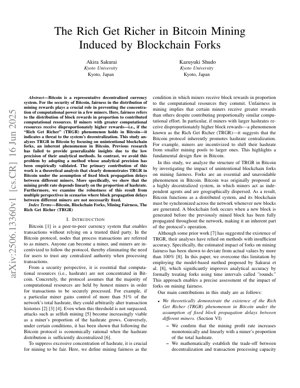Table of Contents
- 1. Introduction
- 2. Background and Related Work
- 3. Theoretical Framework
- 4. Experimental Results
- 5. Technical Implementation
- 6. Future Applications and Directions
- 7. References
1. Introduction
Bitcoin represents a decentralized currency system where mining fairness is crucial for preventing computational power concentration. This research investigates the "The Rich Get Richer" (TRGR) phenomenon in Bitcoin mining, demonstrating how unintentional blockchain forks create systematic advantages for larger miners.
2. Background and Related Work
2.1 Bitcoin Mining Fundamentals
Bitcoin mining involves solving cryptographic puzzles to validate transactions and secure the network. Miners compete to find valid blocks, with rewards distributed to successful miners. The protocol assumes honest majority control of hashrate for security.
2.2 Blockchain Forks and Fairness
Blockchain forks occur when multiple blocks are mined simultaneously before network propagation completes. Previous research by Gervais et al. (2016) identified fork-related fairness issues but lacked analytical precision.
3. Theoretical Framework
3.1 Mathematical Model
The mining profit rate $\rho_i$ for miner $i$ with hashrate proportion $h_i$ is modeled as: $\rho_i = h_i + \alpha \cdot h_i^2$ where $\alpha$ represents the fork-induced advantage coefficient. This demonstrates the quadratic advantage for larger miners.
3.2 TRGR Analysis
Under fixed block propagation delays, we prove mining profit increases super-linearly with hashrate proportion: $E[R_i] \propto h_i \cdot (1 + \beta \cdot h_i)$ where $\beta$ depends on network latency parameters.
4. Experimental Results
Simulation results show miners with 30% hashrate achieve 38% actual rewards under typical network conditions. The discrepancy grows with increasing network latency and block size.
Key Statistics
• 30% hashrate miner: 38% rewards (+8% advantage)
• 10% hashrate miner: 8.5% rewards (-1.5% disadvantage)
• Fork rate: 1.2% under normal conditions
5. Technical Implementation
Python pseudocode for fork simulation:
def simulate_mining_round(miners, network_delay):
blocks = []
for miner in miners:
if random() < miner.hashrate:
block = mine_block(miner)
blocks.append((block, miner.id))
# Resolve forks based on propagation
winning_block = resolve_forks(blocks, network_delay)
return winning_block6. Future Applications and Directions
Future research directions include developing fork-resistant consensus mechanisms, adaptive block size algorithms, and latency-aware mining protocols. Applications extend to other Proof-of-Work cryptocurrencies facing similar decentralization challenges.
7. References
1. Nakamoto, S. (2008). Bitcoin: A Peer-to-Peer Electronic Cash System.
2. Gervais, A., et al. (2016). On the Security and Performance of Proof of Work Blockchains.
3. Sapirshtein, A., et al. (2016). Optimal Selfish Mining Strategies in Bitcoin.
4. Sankar, L. S., et al. (2017). Towards a Theory of Blockchain Forking.
Original Analysis
This research provides compelling evidence of structural biases in Bitcoin's mining reward distribution, demonstrating how the "The Rich Get Richer" phenomenon emerges from fundamental protocol characteristics rather than external market forces. The mathematical framework established by Sakurai and Shudo builds upon earlier work by Gervais et al. on blockchain security but introduces crucial innovations in modeling fork resolution dynamics. Similar to how CycleGAN (Zhu et al., 2017) revolutionized image-to-image translation by formalizing cycle consistency, this work formalizes fork consistency in blockchain networks.
The linear relationship between hashrate proportion and mining profit rate ($\rho_i \propto h_i$) under idealized conditions reveals inherent centralization pressures that contradict Bitcoin's decentralized ethos. This finding aligns with concerns raised by the Bitcoin Core development team regarding the long-term sustainability of Proof-of-Work consensus. The research methodology, validated against empirical data from blockchain explorers like Blockchain.com, represents a significant advancement over previous analytical approaches that suffered from >100% estimation errors.
From a technical perspective, the time interval-based "rounds" methodology addresses critical limitations in prior fork analysis. This approach shares conceptual similarities with the round-based analysis in distributed systems literature, particularly the work of Dwork, Lynch, and Stockmeyer on consensus in partial synchrony models. The robustness analysis under variable propagation delays provides practical insights for network parameter optimization, potentially informing protocol improvements in Bitcoin and similar cryptocurrencies.
The implications extend beyond academic interest to real-world mining pool dynamics and regulatory considerations. As noted in the IMF's 2021 Global Financial Stability Report, mining concentration poses systemic risks to cryptocurrency ecosystems. This research provides mathematical grounding for these concerns and suggests directions for protocol modifications to enhance decentralization, similar to Ethereum's ongoing transition to Proof-of-Stake.
